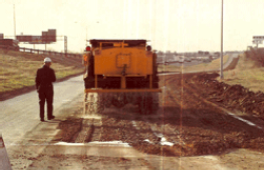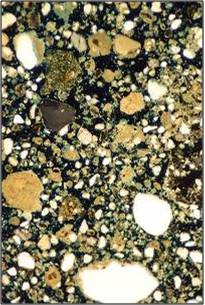
Posts Tagged “soil stabilization”

RoadBond EN-1 Abilene Summary Report
Abilene Roadbond EN-1 Summary Report
Laboratory tests performed on Abilene FM 57 samples treated with Roadbond EN-I involved the Tube Suction Test, Compressive Strength Test at three different confining pressures, construction of the envelope offailure for each sample, and classification of the material. EN-I was mixed with water at a ratio of 1:250. Six samples were made for testing: 1 with no EN-I, 2 with 1% EN-I, 2 with 3% EN-I, and 1 with 5% EN-I.
Samples were mixed in accordance with the mixing instructions provided to ITI at the previously determined OMC of 12.2%. After compaction, the samples were allowed to cure 7 days in the wet room. Following the 7-day cure, the samples were placed in a 104
F room for 6 days to dry in preparation for the Tube Suction Test.
Tube Suction Test Results
At the end of the 10 day Tube Suction Test, no samples had final surface dielectric values greater than 10 (which is the proposed maximum surface dielectric for a material to perform exceptionally in the presence of water). The beginning and ending surface
dielectric values for each sample are below.
Table 1: Initial and Final Dielectric Values for Abilene Tube
Suction Samples
| Sample | Initial Dielectric | Final Dielectric |
| 0% EN-1 | 9.0 | 9.6 |
| 1% EN-1 | 7.8 | 9.4 |
| 1% EN-1 | 8.5 | 9.7 |
| 3% EN-1 | 8.1 | 9.3 |
| 3% EN-1 | 7.6 | 9.3 |
| 5% EN-1 | 8.5 | 9.5 |
Compressive Strength Tests
Compressive strength tests were performed at the end of the Tube Suction Test on one sample of each Roadbond EN-I content. The samples were tested beginning at 1 psi confining pressure, then at 5 psi, and lastly at 10 psi. Because of a lack of material, enough samples were not available to test a new sample at each confining pressure. Due to this constraint, the failure point for each sample was estimated to be where the ones digit on the load had to change four times before the tens digit would change.
In compressive testing, all treated samples had a higher maximum strength value than the untreated sample. The maximum strength values are in Table 2, along with the maximum and minimum gains from treating the samples with EN-I
Table 2: Compressive Strength of Abilene after Tube Suction Tests
| Confining Pressure | 0% EN-1 psi | 1% EN-1 psi | 3% EN-1 psi | 5% EN-1 psi | Max Strength Gain | Min Strength Gain |
| 1 psi | 41.9 | 65.8 | 63.7 | 76.0 | 81% | 52% |
| 5 psi | 63.6 | 85.4 | 85.6 | 101.0 | 59% | 34% |
| 10 psi | 88.9 | 109.0 | 114.8 | 125.6 | 41% | 23% |
Classification Of Material
After strength testing and construction of Mohr's diagrams, the failure envelopes for the samples were transposed onto the Chart for Classification of Subgrade and Flexible Base Material (attached). From testing, the classification of the materials is as follows:
• 0% EN-I: Class 3.0
• 1% EN-I: Class 2.4
• 3% EN-I: Class 2.3
• 5% EN-I: Class 2.1
Conclusion
In laboratory testing, all of the Abilene FM 57 samples prepared passed the Tube Suction Test with final dielectric values less than 10. Samples with 0, 1,3, and 5% EN-I underwent this test. Following the Tube Suction Test, the samples were strength tested. It was found that the Roadbond EN-I treated samples were significantly stronger than the untreated. At the manufacturers' recommended 3% level of treatment, the treated sample had strength gains of 52%, 34%, and 23% over the untreated sample (at 1, 5, and 10 psi confining pressure, respectively). The strength gains from treatment were sufficient to move the Abilene material from a Class 3.0 for the untreated sample to Class 2.1 for the sample treated with 5% EN-I mixture. The sample treated with 3% EN-I mixture was determined to have a class of 2.3. Currently all the samples are sealed and in a wet room, as more studies are planned to investigate what kind of chemical and/or physical changes took place to cause the observed strength gains apparently from EN-I treatment.

Soil Stabilizer Roadbond – Talem Inc
Executive Summary: Review of Texas Transportation Institute Report 3929-1
ROADBOND ENI RECEIVES mGH MARKS IN TEXAS TRANSPORTATION INSTITUTE STUDY
ENTITLED “REDUCTION OF SULFATE SWELL IN EXPANSIVE CLAY SUBGRADES IN THE
DALLAS DISTRICT.
Texas Transportation Report 3929-1: THE TWO MAlN OBJECTIVES OF rms RECENTLY COMPLETED
TEXAS TRANSPORTATION INSTITUTE STUDY WERE (1) to determine effective means of identifying high
.sulfate soils and (2) to identify alternative non-calcium based soil stabilizers that could be effectively substituted for lime. It has been well documented that lime does not perform well as a stabilizer in high sulfate soils due to excessive swell problems. The study evaluated several techniques for identifying high clay soils and five noncalcium products were selected for comparison to lime as soil stabilizers at two high sulfate test sites. The selection criteria specified that the non-calcium stabilizer must be readily available and inexpensive. The ,– products selected were Roadbond ENI, EMC Squared (EMC2), Claypack, potassium hydroxide, and ammonium chloride.
This study was well planned and the report was exceedingly detailed. The report contained 159 pages of tables, graphs, and technical commentary. Regarding objective number one, the study determined that simple instrumental tests designed to measure electrical conductivity and dielectric constant can effectively be used to identify high sulfate soils. The study results showed that the non-calcium commercial stabilizers Roadbond ENI and EMC2 were superior to lime in strength, stiffness, swell resistance and permeability. Furthermore, these two proprietary products appeared to stabilize the soil, making it more impervious, increasing its strength and stiffness, and reducing the swell-shrink problems created by the expansive lime-sulfate reaction. At the State Highway (SH) 161 site Roadbond ENI applied @ 1:500 (one part product by weight to 500 parts water by volume) achieved the best results while EMC2 @1:220 achieved the best results at Interstate Highway (IH) 635. With respect to strength at failure and stiffness, both Roadbond EN1 and EMC2 outperformed lime at both study
sites. With respect to the swell test, Roadbond EN1 achieved the best results at both sites at application rates of 1:500 and 1:300 respectively. Of all the samples, the maximum swell occurred with the lime treated samples from both sites.
Finally, the study established the superiority of the commercial stabilizers Roadbond EN1 and EMC2 to lime in strength, stiffness, swell resistance, and permeability. The study further substantiated that since these commercial products produce stabilized soils with lower permeability and a lower suction than the soils beneath it; the stabilized soils shed rain better and did not soak up water from the soils beneath them. The report concluded that the non-calcium commercial stabilizers when applied at the appropriate rates were more effective at stabilizing high sulfate expansive soils than lime. The report recommends that the product manufacturers be consulted regarding optimum application procedures and application rates. While the study made no effort to determine structural permanence of soils stabilized with non-calcium treatments, the study does show that both Roadbond ENI and EMC2 are superior to Lime at reducing swell in high sulfate expansive soils. Although the report indicates that both Roadbond EN 1 and EMC2 were effective as well as economical no detailed cost comparisons are provided and the authors were careful not to endorse a particular product. For more detail the full report should be consulted.